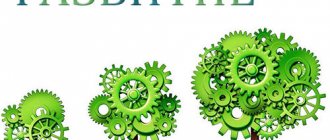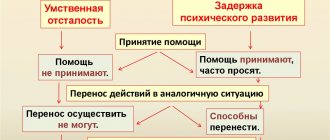The mental development of a child is a very complex, subtle and lengthy process, which is influenced by many factors.
An idea of how this or that stage goes will help you not only better understand your child, but also notice developmental delays in time and take appropriate measures. The generally accepted periodization of the development of the child’s psyche was developed by the Soviet psychologist Daniil Borisovich Elkonin. Even if you have never encountered his works, this system is familiar to you: in the annotations to children's publications it is often indicated that this work is “for preschool age” or “for primary schoolchildren.”
Elkonin’s system describes the mental development of a child from infancy to 15 years, although in some of his works the age of 17 years is indicated.
According to the scientist, the characteristics of each stage of development are determined by the leading activity of the child at a particular age, within the framework of which certain mental new formations appear.
Infancy
This stage covers the period from birth to one year. The leading activity of the baby is communication with significant figures, that is, adults. Mainly mom and dad. He learns to interact with others, express his desires and respond to stimuli in ways accessible to him - intonation, individual sounds, gestures, facial expressions. The main goal of cognitive activity is knowledge of relationships.
The task of parents is to teach the child to “communicate” with the outside world as quickly as possible. Games for the development of large and fine motor skills and the formation of a color scheme will help with this. Among the toys there must be objects of various colors, sizes, shapes, textures. Until one year, the child does not experience any experiences other than natural ones: hunger, pain, cold, thirst, and is not able to learn the rules.
How to strengthen the nervous system and psyche of a child?
If there are any problems with the child’s psyche, then you must, first of all, exclude all factors that may negatively affect the child’s psycho-emotional health. Psychologists advise modern parents to adhere to the following recommendations:
- Do not solve any problems in the presence of the child - no matter what they concern.
- Don't talk loudly or be aggressive towards anyone. Even if your cat or dog shits at home, do not scream, but behave calmly and balanced.
- Show your child by personal example what his daily routine and diet should be. Eat the same things that you give him, sleep with him in the same mode, walk, exercise, lead an active lifestyle, but not alone, but together with your child.
- Give him traditional soothing decoctions - valerian, mint, motherwort. Do not use sedatives, because apart from addiction, they will not bring anything good to your child.
Surround your child with love, care and attention. Talk to him, act as if he is already an adult with whom you can communicate as an equal. Thanks to our advice, you will be able to raise a full-fledged and cheerful person who will do good throughout life and give joy to other people.
Early childhood
It lasts from 1 year to 3 years. The leading activity is manipulative-objective activity. The child discovers many objects around him and strives to explore them as quickly as possible - taste them, break them, etc. He learns their names and makes his first attempts to take part in the conversation of adults.
Mental new formations are speech and visual-effective thinking, that is, in order to learn something, he needs to see how this action is performed by one of the elders. It is noteworthy that at first the child will not play independently, without the participation of mom or dad.
Features of the early childhood stage:
- comprehension of the names and purposes of objects, mastering the correct manipulation of a specific object;
- mastering established rules;
- the beginning of awareness of one’s own “I”;
- the beginning of the formation of self-esteem;
- gradual separation of one’s actions from the actions of adults and the need for independence.
Early childhood often ends with the so-called crisis of 3 years, when the child sees pleasure in disobedience, becomes stubborn, literally rebels against established rules, sharp negative reactions increasingly appear, etc.
Preschool age
This stage begins at 3 years and ends at 7 years. The leading activity for preschoolers is play, or rather, role-playing game, during which children learn relationships and consequences. The personal sphere of the psyche is actively developing. Age-related neoplasms are a need for social significance and activity.
The child can move independently, his speech is understandable to adults, and he often feels like a full participant in communication.
- He understands that all actions and actions have a specific meaning. When teaching, for example, hygiene rules, explain why this is necessary.
- The most effective way to absorb information is through play, so role-playing games should be played every day. In games, you should not use real objects, but their substitutes - the simpler the better for the development of abstract thinking.
- The preschooler experiences an urgent need to communicate with peers and learns to interact with them.
Towards the end of the stage, the child gradually gains independence, is able to determine the cause-and-effect relationship, is able to take responsibility for his actions, and obeys the rules if he sees them as reasonable. He learns good habits, rules of politeness, norms of relationships with others, strives to be useful, and willingly makes contact.
Junior school age
This stage lasts from 7 to 11 years and is associated with significant changes in the child’s life and behavior. He enters school, and play activities give way to educational activities. The intellectual and cognitive sphere is actively developing. Age-related mental neoplasms: voluntariness, internal plan of action, reflection and self-control.
What does it mean?
- He is able to concentrate for a long time on a specific lesson: sit quietly at his desk during a lesson and listen to the teacher’s explanations.
- Able to plan and perform tasks in a certain sequence, for example, when doing homework.
- He determines the boundaries of his knowledge and identifies the reason why, for example, he cannot solve a problem, what exactly is missing for this.
- The child learns to control his actions, for example, first do his homework, then go for a walk.
- He experiences discomfort from the fact that an adult (teacher) cannot give the amount of attention that he is used to receiving at home.
A younger student can more or less accurately assess the changes that have occurred in his personality: what he could do before and what he can do now, learns to build relationships in a new team, and obey school discipline.
The main task of parents during this period is to emotionally support the child, closely monitor his mood and feelings, and help him find new friends among classmates.
Ontogenesis is a gradual change in the organism, occurring in stages in the form of quantitative and qualitative shifts, from a less to a more perfect structure and functioning.
Ontogenesis, in essence, of this concept should be attributed to the entire period of a person’s life from birth to death, that is, include not only progressive, but also regressive, involutional changes. But more often they talk about ontogenesis in relation to childhood, and it is in this sense that this concept is used In chapter.
Each stage of ontogenesis constitutes a transition from one qualitative state of the organism to another, higher one by transforming its functioning without displacing the qualitative level of the previous stage. In other words, in the body there is a gradual differentiation of certain (including mental) processes with their simultaneous integration into a new whole In the psychological aspect, this is an increase in the mental content of the personality
The periodization of the development of the human body, introduced by K. Behr back in the last century (1826), subsequently became widespread. It formed the basis of modern ideas about the stages (stages, phases) of the development of the body
In domestic and world practice, 4 main stages of psychophysical development
in childhood - from birth to 14 years The first stage is early (from 0 to 3 years), the second is preschool (from 4 to 6 years), the third is school (from 7 to 10 years), the fourth is puberty, or rather school- puberty (from 12 to 14 years). In addition to the stated stages, the medical literature often uses the concept of “children” and “adolescents.” The adolescence period includes the period of life from puberty to adulthood (youth) - most often the age of 12-16 years is meant, but sometimes it is expanded - 11-17 years.
The process of ontogenesis in childhood also includes the so-called critical periods, or transition from one stage of development to another. It is customary to distinguish 3 critical periods
I - from 2 to 4 years, II - from 7 to 8 years and III - puberty - 12-14 years. Critical periods are short periods of time characterized by rapid changes in the functioning of the body, general and mental reactivity. They are of great interest for clinical medicine, since these changes cause an increased risk of the occurrence of any diseases, including mental ones, and contribute to the aggravation of their course.
The normal mental development of a child is a complex process, which is based on a species-specific and genetic program that is implemented under conditions of constant change in environmental factors. Mental development is closely related to the biological properties of the body, its hereditary and constitutional characteristics, congenital and acquired qualities, mediated by the gradual formation of the structure and function of various parts of the central nervous system. The rates of formation of individual brain systems are different and this determines the physiological heterochrony of its growth and development, reflected in different rates of maturation of individual psychophysiological functions. These differences also include individual variations.
The main factors influencing mental development include heredity, family environment and upbringing, as well as the external environment with the diversity of its social and biological influences. All these influences act in a single complex, which can determine both the strengthening and leveling of the influence of each factor.
In recent decades, interest in psychology, neurology and psychiatry of early childhood has increased in domestic and foreign medicine [Badalyan L. O., Zhurba L. T., 1980; Lisina M.N., 1980; Mastyukova E. M., 1980; Shevchenko B. S., 1993; Kozlovskaya V. G., 1996; Goryunova A.V., 1997; Anthony E., 1982; Greenspan S., 1992; Stern D., 1994].
In the psychogenesis of early life, the following stages were additionally identified: the neonatal period
(age 1-1.5 months);
infancy
– period up to 1 year;
toddler period
- 2nd and 3rd years of life. Critical periods were also identified - prenatal and early childhood: 15-25 and 28 weeks of pregnancy, III trimester of pregnancy (30-40 weeks), prenatal period (3-5 days before birth) and childbirth, neonatal stage (1 -1.5 months), age 6-8 months, age 15-17 months and age 2.5-3.5 years.
The given periodization was initially identified empirically by psychologists and doctors, but then it was confirmed in special neuropsychological, neuromorphological and neurophysiological studies [Borovova A. I., Galkina N. S., 1992; Stroganova T. A., 1995; Hersckowitz N., 1990].
From the point of view of neuromorphology, the critical periods of early childhood represent, as it were, the peak of structural transformations occurring at the corresponding stage. Thus, the critical period of 15-28 weeks of intrauterine development of the fetus corresponds to the formation of subcortical structures of the brain, 28 weeks - the formation of structures of the cerebral cortex. Psychologically, the third trimester of pregnancy is characterized as the appearance of elements of auditory memory and correlations of fetal behavior with the mental state of the mother.
The prenatal period and childbirth combine hibernation, or preparation for the act of childbirth in the form of prenatal suspended animation of the fetus, and childbirth itself is equated in relation to the fetus to stress, which causes in it a state of deep nervous and psychophysical tension, associated with the possibility of transformation into a reaction of distress with risk development of one or another pathology.
The first month of life, or the neonatal period, correlates with the beginning of an undifferentiated perception of one’s self. The first days of a child’s life, which are characterized by the Konrad Lorenz imprinting phenomenon, or the “imprinting” phenomenon, are of particular importance in it. We are talking about the first contact of a newborn, eye-contact with a human face, primarily with the mother. It is believed that this contact is a factor that largely determines all further mental development of the child.
The next sensitive stage of the newborn period is the age of 3-4 weeks. It is also called the period of primary social behavior in the form of eye contact with the outside world (early-eye-contact baby). This period is characterized by the development of primary positive and negative feelings and ideas about the world around us.
The critical period, attributed to the age of 6-8 months, is determined by the beginning of differentiation of the sense of self, individualization of the self, as well as the beginning of the formation of primary attachment, selective “smile” and elementary social preferences.
The critical period at the age of 15-17 months is determined by the appearance of primary motivation for behavior, determined mainly by the vital needs of the body, and then secondary motivation, characterized by an orientation towards the assessment of behavior by others and the gradual identification of positive behavioral experience with the approval of people close to the child. During the critical period under consideration, the described features appear, but their formation within it, naturally, does not end and their development continues at an older age. It should also be noted that at 15-17 months, intensive maturation of the cells of the cerebral cortex occurs (it begins at 28 weeks of pregnancy and continues until adolescence - 18-20 years). This also corresponds to significant changes in biological brain rhythms, which is reflected in electroencephalographic characteristics.
The last critical period of early ontogenesis, as already indicated, refers to the age of 2.5-3.5 years. It is defined as the period of formation of self-awareness, complete separation of the Self and individuality. At this stage, the child already has not only positive, but also negative experience of relationships with the outside world, with feelings of threat, anxiety, guilt and low mood. But the most significant changes for this period are the changes associated with the transition from a full and partial symbiotic relationship with the mother to a sense of independence. It is no coincidence that this period is sometimes called “revolutionary” and “the first pubertal crisis” [Badalyan L. O., 1975; Manova-Tomova V., Pirvov G., 1981; Wolff S., 1989].
Dysontogenesis
is a violation of the development of an organism at any stage of ontogenesis
. Mental dysontogenesis -
pathology of mental development with changes in the sequence, rhythm and pace of the process of maturation of mental functions. The development of the content of this concept in domestic child psychiatry is associated with the names of G. E. Sukhareva, M. Sh. Vrono, G. K. Ushakov, V. V. Kovalev, A. E. Lichko.
In clinical psychiatry, the term “dysontogenesis” refers to delays and distortions of mental development. The group of disorders united by the concept of “mental retardation” includes pathological conditions characterized by insufficient intelligence and the psyche as a whole. “Distortions of mental development” include conditions characterized by partial and dissociative development of mental functions. Some of them may be characterized by acceleration, while others may be characterized by delayed development.
Delays in mental development should be distinguished from acquired states of personality defect and intellectual activity due to a disease process or other damage to the psyche. In the latter case, it is customary to talk about dementia, or dementia.
Within the framework of mental underdevelopment, a distinction is made between severe mental states (retardation) and relatively mild mental development delays (borderline forms of developmental delay).
Dysontogenesis of mental development can occur under the influence of many internal and external factors (genetic, biological, psychogenic and microsocial), as well as their combination and interaction. Among the main ones can be named residual organic cerebral insufficiency, which in foreign literature is defined by the capacious concept “ minimal brain dysfunction" (minimal brain dysfunction - MBD). When specifying these factors in relation to early childhood, attention is paid to the characteristics of temperament, somatic and organic cerebral pathology, a complex of emotional attachments, deprivation (including partial orphanhood - the death of "one of the parents , divorce).
Temperament factor
begins to act and is determined from the 1st month of the child’s life. Nine components of temperament have been identified: activity, rhythm (cyclicity), sensitivity (reactivity), intensity, mobility, communication, adaptability, mood, attention (its volume). Each of these characteristics determines the child’s different behavior and reactions in any life situation. Based on the type of infant’s reactions when studying temperament, one can identify a group of so-called difficult children who are predisposed to mental dysontogenesis.
Traditionally, organic factors for the occurrence of dysontogenesis have been considered. include cerebral pathology,
structural, i.e. organic brain lesions and functional disorders of brain activity. But with the latter, the presence of “soft” organic signs is allowed. It is in this case that we speak of the already mentioned minimal brain dysfunction.
The last two factors of dysontogenesis are a complex of emotional attachment
and
deprivation
are essentially psychosocial and closely related. The connection between the child and mother that arises from the first hours and days of a newborn’s life has a decisive influence on the formation of all other connections and attachments and their varying emotional depth, which largely determine the psychological reactivity and behavior of the individual throughout life.
Deprivation can be complete or partial, sensory and emotional. But in any of the variants, it has a great influence on the mental development of the child, leading to its disruption, i.e. dysontogenesis.
Manifestations of mental dysontogenesis are varied. According to M. Sh. Vrono (1983), the clinical picture of mental dysontogenesis depends primarily on the age of the child and, accordingly, on the stage of ontogenesis, i.e. the author emphasizes the chronogenic aspect of dysontogenesis.
V.V. Kovalev (1981) distinguishes 4 types of dysontogenesis: 1) delayed or distorted mental development; 2) organic dysontogenesis - as a result of brain damage in the early stages of ontogenesis; 3) dysontogenesis due to damage to individual analyzers (vision, hearing) or sensory deprivation; 4) dysontogenesis as a result of a lack of information from an early age due to social deprivation (including improper upbringing). Recognizing the variety of types of mental dysontogenesis, V.V. Kovalev nevertheless combines them into 2 main options - dysontogenesis with negative symptoms and dysontogenesis with productive syndromes. He includes the first syndromes of mental underdevelopment - total (oligophrenia) and partial retardation (mental retardation), acceleration, various forms of infantilism, and neuropathy. The second option includes cases when, against the background of clinical manifestations of negative dysontogenetic disorders, productive phenomena develop: fears, pathological habitual actions, enuresis, encropresis, increased sloppiness, loss of walking, speech, self-care skills, transition of mental functioning to earlier stages of development, as well as affective disorders, drive disorders, hyperactivity, pathological fantasy, heboid, catatonic and other syndromes.
Thus, the main forms of dysontogenesis include mental development delays (total and partial) and mental development distortions (acceleration, infantilism, etc.).
Recently, another form of mental dysontogenesis has been identified - diathesis, which is an expression of a predisposition to certain mental illnesses [Anufriev AK Kozlovskaya GV 1985; Tsirkin S.Yu., 1995].
In psychiatry, schizotypal diathesis is the most studied as a clinical expression of a genetic predisposition to schizophrenia [Kozlovskaya G. V. Goryunova A. V., Rimashevskaya N. V., 1986]. Theoretically, the identification of nonspecific mental diathesis as a prerequisite for other mental disorders is justified [Tsirkin S. Yu., 1995].
Thus, mental dysontogenesis is a group of mental disorders observed in childhood, classified as so-called evolutionary pathological conditions [Kovalev V.V., 1982].
Mental disorders during dysontogenesis differ from such developmental anomalies as post-processual (post-schizophrenic) defect, dementia due to organic cerebral disease. In these cases, mental dysontogenesis is one of the syndromes of the underlying disease. The syndrome of immaturity of neuropsychic functions in the form of delayed psychomotor development is one of the main psychoneurological, undifferentiated formations in the structure of diseases not only of the nervous system, but also of chronic, somatic pathology, including hereditary ones. Disorders of mental development that occur at an early age may underlie mental disorders that develop at an older age.
Clinical forms of pathology of mental development can be systematized as follows:
- Mental retardation
- Mental development delays (borderline and partial)
- Distortions and other mental development disorders
- Autistic disorders
- Acceleration
- Infantilism
- Somatopathies
- Special forms of mental dysontogenesis in children from high-risk groups for mental pathology
This taxonomy is somewhat different from that given in many textbooks on child psychiatry, including the taxonomy of M. Sh. Vrono in the manual edited by A. V. Snezhnevsky (1983). The introduction into it as a separate group of disorders reflecting distortions of mental development is justified by the results of many years of research begun by O. P. Yuryeva (1970) and continued by G. V. Kozlovskaya et al. (1986, 1995), which made it possible to trace the dynamics of children’s development from birth to adolescence and beyond and showed the uniqueness of certain forms of mental development disorders (especially in children at high risk for mental pathology).
The given clinical forms of pathology of mental development in ICD-10 are included in 3 sections: “Mental retardation” (headings F70-79), “Disturbances of psychological development” (P80-89), “Behavioral and emotional disorders beginning in childhood and adolescence” (F90-98).
A common feature of mental disorders in children, especially in infancy, is a combination of manifestations of the progressive dynamics of development of mental functions and their dysontogenesis, caused by a violation of the formation of morphofunctional systems of the brain. These types of disorders may be the result of congenital characteristics of the nervous system, cerebral distress and microsocial influences. In this age period, the hypothesis about the three-axis, or three-level, structure of the etiology of mental illnesses is confirmed, when three types of factors of equal causal significance interact - genetic, exogenous-cerebral and psychosocial, which is reflected in the polymorphism of the clinical picture and makes it necessary to implement an individual approach to construction of therapeutic and preventive measures [Kozlovskaya G.V., Bazhenova O.V., 1995].
Adolescence
This is the “transitional age”, which lasts from 11 to 15 years and the onset of which all parents await with horror. The leading activity is communication with peers, the desire to find one’s place in the group, receive its support and at the same time stand out from the crowd. The need-motivational sphere of the psyche develops mainly. Mental neoplasms – self-esteem, desire for “adulthood”.
The teenager is torn between the desire to grow up quickly and to maintain a certain impunity for as long as possible, to relieve himself of responsibility for his actions. He learns about the system of relations between the sexes, tries to build his own, rebels against prohibitions and constantly breaks the rules, fiercely defends his point of view, seeks his place in the world and at the same time amazingly easily falls under the influence of others.
Some guys, on the contrary, immerse themselves in their studies, their transitional age is, as it were, “transferred” to a later time, for example, they may well begin their rebellion even after graduating from university.
Parents face a difficult task - to find a common language with a teenager in order to protect him from rash actions.
Adolescence
Some psychologists identify another stage of mental development - this is adolescence, from 15 to 17 years. Educational and professional activities become the leading ones. Personal and cognitive spheres develop. During this period, the teenager matures sharply, his decisions become more balanced, he begins to think about the future, in particular, about choosing a profession.
Growing up is difficult at any age - at 3 years old, at 7, and at 15 years old. Parents must understand well the characteristics of their child’s mental development and help him successfully overcome all age-related crises, direct the formation of his character and personality in the right direction.
Date of publication: 06/26/2017. Last modified: 05/09/2018.
Children with mental retardation
Mental retardation (mental retardation) may not manifest itself at the physical level, so until a certain age parents are not even aware of such a diagnosis. However, problems with social adaptation and schooling should alert them. Only a specialist can make a diagnosis of mental retardation, but parents can identify it based on several characteristic signs.
- Firstly, for attention disorders. The child is constantly distracted, cannot concentrate on a specific task, and shows increased motor activity.
- Secondly, in case of disturbances of perception, when it is difficult for him to identify long-familiar objects in a new perspective or setting. Or the child may not remember the names of people he sees often. There is also a lag in the development of forms of thinking, especially in building logical chains. This also includes problems with speech and underdevelopment of the lexical and grammatical aspects.
The diagnosis of mental retardation itself is not an obstacle to studying in general education programs; however, it requires adjustment taking into account the characteristics of the child’s development.










